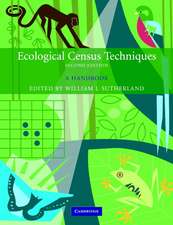The Acheulian Site of Gesher Benot Ya’aqov Volume II: Ancient Flames and Controlled Use of Fire: Vertebrate Paleobiology and Paleoanthropology
Autor Nira Alperson-Afil, Naama Goren-Inbaren Limba Engleză Hardback – 6 mai 2010
| Toate formatele și edițiile | Preț | Express |
|---|---|---|
| Paperback (1) | 385.84 lei 6-8 săpt. | |
| SPRINGER NETHERLANDS – 28 iun 2012 | 385.84 lei 6-8 săpt. | |
| Hardback (1) | 380.72 lei 38-44 zile | |
| SPRINGER NETHERLANDS – 6 mai 2010 | 380.72 lei 38-44 zile |
Din seria Vertebrate Paleobiology and Paleoanthropology
- 15%
 Preț: 717.13 lei
Preț: 717.13 lei -
 Preț: 314.69 lei
Preț: 314.69 lei - 15%
 Preț: 724.12 lei
Preț: 724.12 lei - 18%
 Preț: 738.34 lei
Preț: 738.34 lei - 18%
 Preț: 741.37 lei
Preț: 741.37 lei - 15%
 Preț: 719.39 lei
Preț: 719.39 lei - 18%
 Preț: 635.91 lei
Preț: 635.91 lei -
 Preț: 411.04 lei
Preț: 411.04 lei - 20%
 Preț: 606.45 lei
Preț: 606.45 lei -
 Preț: 392.60 lei
Preț: 392.60 lei - 20%
 Preț: 617.47 lei
Preț: 617.47 lei - 15%
 Preț: 650.19 lei
Preț: 650.19 lei -
 Preț: 397.38 lei
Preț: 397.38 lei - 20%
 Preț: 619.35 lei
Preț: 619.35 lei -
 Preț: 391.27 lei
Preț: 391.27 lei -
 Preț: 431.73 lei
Preț: 431.73 lei -
 Preț: 433.47 lei
Preț: 433.47 lei - 24%
 Preț: 715.31 lei
Preț: 715.31 lei -
 Preț: 449.63 lei
Preț: 449.63 lei - 24%
 Preț: 763.00 lei
Preț: 763.00 lei - 15%
 Preț: 715.31 lei
Preț: 715.31 lei - 24%
 Preț: 636.37 lei
Preț: 636.37 lei - 20%
 Preț: 631.45 lei
Preț: 631.45 lei - 18%
 Preț: 792.19 lei
Preț: 792.19 lei - 20%
 Preț: 604.46 lei
Preț: 604.46 lei - 15%
 Preț: 708.75 lei
Preț: 708.75 lei -
 Preț: 404.29 lei
Preț: 404.29 lei - 24%
 Preț: 645.20 lei
Preț: 645.20 lei -
 Preț: 383.95 lei
Preț: 383.95 lei - 18%
 Preț: 898.13 lei
Preț: 898.13 lei -
 Preț: 403.75 lei
Preț: 403.75 lei
Preț: 380.72 lei
Nou
Puncte Express: 571
Preț estimativ în valută:
72.86€ • 75.79$ • 60.15£
72.86€ • 75.79$ • 60.15£
Carte tipărită la comandă
Livrare economică 10-16 aprilie
Preluare comenzi: 021 569.72.76
Specificații
ISBN-13: 9789048137640
ISBN-10: 9048137640
Pagini: 120
Ilustrații: XXVIII, 120 p. 82 illus.
Dimensiuni: 210 x 279 x 20 mm
Greutate: 0.57 kg
Ediția:2010
Editura: SPRINGER NETHERLANDS
Colecția Springer
Seria Vertebrate Paleobiology and Paleoanthropology
Locul publicării:Dordrecht, Netherlands
ISBN-10: 9048137640
Pagini: 120
Ilustrații: XXVIII, 120 p. 82 illus.
Dimensiuni: 210 x 279 x 20 mm
Greutate: 0.57 kg
Ediția:2010
Editura: SPRINGER NETHERLANDS
Colecția Springer
Seria Vertebrate Paleobiology and Paleoanthropology
Locul publicării:Dordrecht, Netherlands
Public țintă
ResearchCuprins
Framework of Research.- Results.- Discussion and Conclusions.
Notă biografică
Nira Alperson-Afil and Naama Goren-Inbar both teach prehistoric archaeology at the Institute of Archaeology of the Hebrew University of Jerusalem. Their main research interest is the prehistory of the Levant, including technological, cultural, and behavioral aspects of our ancient ancestors.
Textul de pe ultima copertă
The manipulation of fire by early hominins was a turning point in our evolutionary history. Once "domesticated", fire provided warmth, light and protection from predators, as well as enabling the exploitation of a new range of foods. This book presents the spatial analyses of burned and unburned flint items which provide evidence for the controlled use of fire at the 790,000-year-old Acheulian site of Gesher Benot Ya‘aqov (GBY). Clusters of burned flint, interpreted as the remnants of hearths, occur throughout the entire occupational sequence of the site. The fact that fire is repetitively used suggests that the knowledge of fire-making and the technological skills of the Acheulian hominins of Gesher Benot Ya‘aqov enabled them to set fire at will in diverse environmental settings.
"Control of fire marks a significant landmark in human evolution, providing warmth, protection, and many new foods. This important volume compellingly shows that fire was already in regular use some 800,000 years ago." John D. Speth, Museum of Anthropology, University of Michigan, Ann Arbor, USA
"A major contribution to knowledge of early human fire history, the finds at Gesher Benot Ya‘aqov add immensely to the picture of our early ancestors by the fireside. The authors present a painstaking and multidimensional scientific investigation which should convince even sceptics of the importance of fire use in prehistory" John A.J. Gowlett, British Academy Centenary Research Project, The Archaeology of the Social Brain, UK
"Control of fire marks a significant landmark in human evolution, providing warmth, protection, and many new foods. This important volume compellingly shows that fire was already in regular use some 800,000 years ago." John D. Speth, Museum of Anthropology, University of Michigan, Ann Arbor, USA
"A major contribution to knowledge of early human fire history, the finds at Gesher Benot Ya‘aqov add immensely to the picture of our early ancestors by the fireside. The authors present a painstaking and multidimensional scientific investigation which should convince even sceptics of the importance of fire use in prehistory" John A.J. Gowlett, British Academy Centenary Research Project, The Archaeology of the Social Brain, UK
Caracteristici
The manipulation of fire by early hominins was a turning point in our evolutionary history This volume features the first time record of controlled use of fire in Eurasia in the Acheulian culture as early as 780.000 years ago Includes supplementary material: sn.pub/extras























